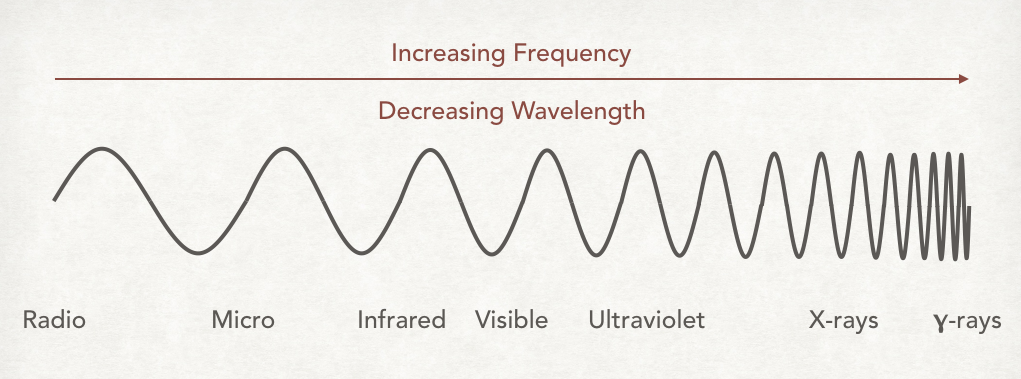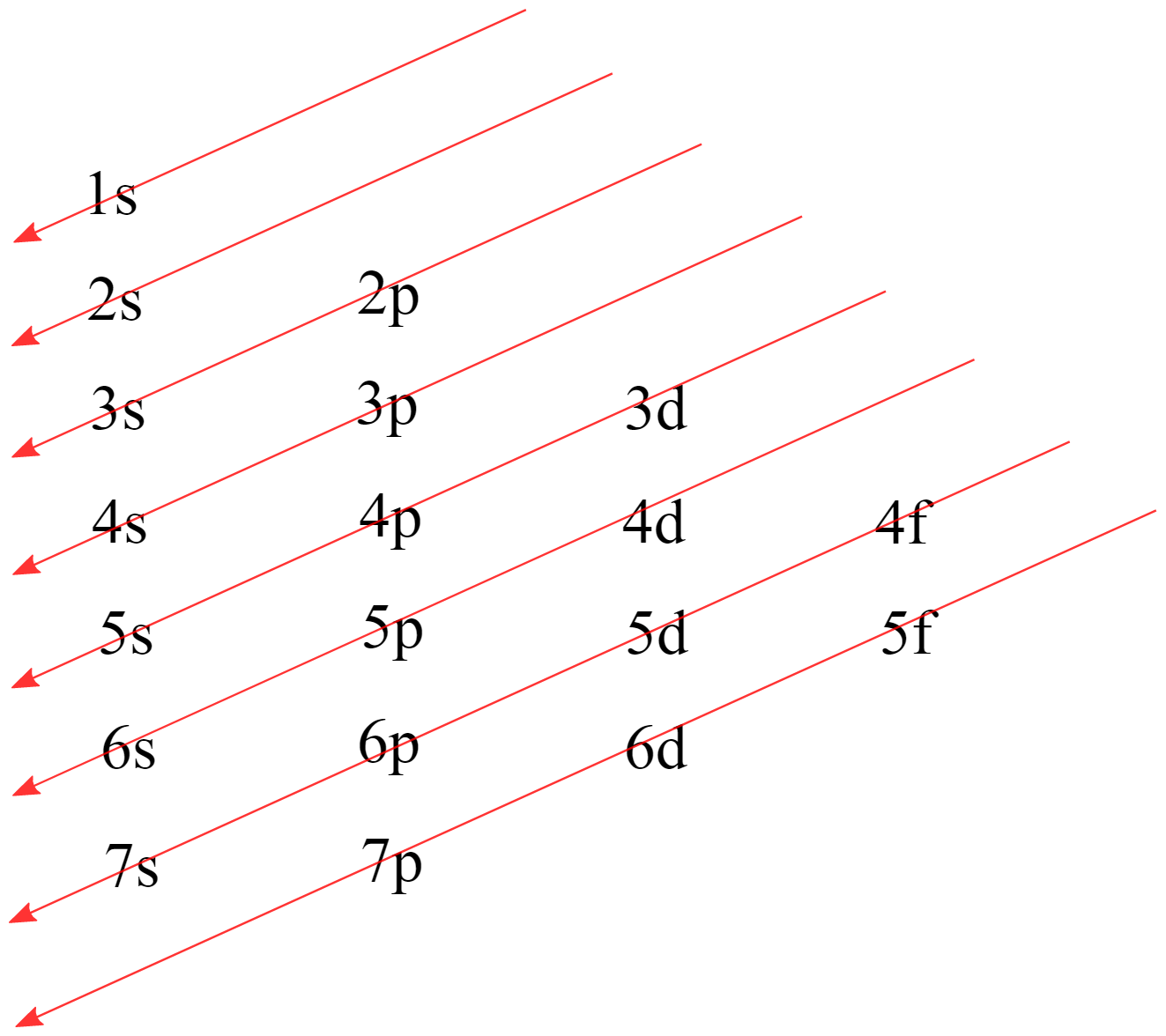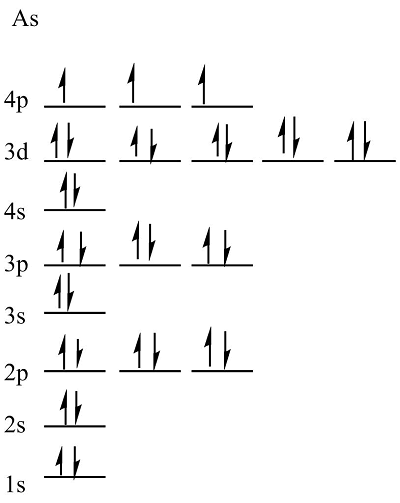Modern Atomic Theory Review
^^light is a form of electromagnetic radiation^^
- properties of both waves and particles:
- wavelength (λ) - the distance between adjacent wave crests, meters
- red light (750 NM) has longest wave length
- violet light (400 NM) has shortest wave length
- ==1 NM = 1 * 10^-9 meters==
- frequency (v) - number of cycles or crests that pass through a stationary point in one second
- amplitude - the height of the wave from zero to crest
- ^^wavelength and frequency are inversely/indirectly related^^ - the shorter the wavelength, the higher the frequency

- ==speed of light====: 2.998 * 10^8 meters/second = λv==
electromagnetic radiation
- light can be viewed as a stream of particles
- particle of light is a ^^photon^^
- photon - a single packet of light energy
- has specific wavelength, determines what light we see
- wavelengths of spectral lines are characteristics of the element
- make up atomic emission spectra
- no two elements have the same emission spectra
- amount of energy carried in the packet depends on the wavelength of the light - ^^the shorter the wavelength, the greater the energy^^
- light waves that carry more energy in their crests are closer
- violet light carries more energy per photon than red light
- the photoelectric effect - the emission of electrons from a metal when light shines on the metal
- ^^quantum of energy^^ - the minimum quantum of energy that can be lost or gained by an atom
- ^^quantized^^: an electron has to absorb/emit a specific amount of energy to move from one energy level to another
- ^^ground state^^: the normal energy level any given electron occupies
- ^^excited state^^: the energy level an electron occupies when it has absorbed the specific quantum of energy to move up to that level
- %%Planck’s Law%% - ==E=Hv==
- E - energy, joules
- H - ==Planck’s constant, 6.626 * 10^-34 J*S==
- v - frequency
%%Bohr’s Model%%
- Niels Bohr changed Rutherford’s model to include newer discoveries about how the energy of an atom changes when the atom absorbs/emits energy
- proposed electron is found only in specific circular paths/orbits around the nucleus ❌
- incorrect - if the orbits were truly circular, the electron would spiral into the nucleus
- each possible electron orbit has a fixed energy - ^^energy level^^ ✅
- each orbit is a specific distance from the nucleus and at each specific energy
- ^^impossible for an electron to exist between orbits^^
- ^^amount of energy is directly related to the frequency → wavelength^^
%%de Broglie%%: proposed “electrons be considered as waves confined to the space around an atomic nucleus”
%%Heisenberg Uncertainty Principle%%
- Werner Heisenberg
- states that it is impossible to determine simultaneously both the position and velocity of an electron
- “we cannot know both the position and speed of a particle, such as a photon or electron, with perfect accuracy”
- %%Schrödinger Wave Equation%%
- Erwin Schrödinger developed an equation that treated electrons as waves
- ^^Quantum Theory^^ - describes mathematically the wave properties of electrons
- electrons exist in certain regions called orbitals
- orbitals - 3D regions around the nucleus that indicate the probable location of an electron
- represent probability maps showing a statistical attribution of where the electron is likely to be found
- 4 Wave Properties
- ^^Energy Level^^: Principal Quantum Numbers - number specifying the principle shell of orbital
- n - indicates the energy level
- energy increases with principal quantum number
- maximum of 7 energy levels
- ==n^2== - how many orbitals in any energy level
- ==2n^2== - maxim. number of electrons possible in any energy level
- ^^Sub Level^^: Shapes of Quantum Mechanical Orbitals
- letter indicates subshell of orbital, specifies shape
- possible letters - s, p, d, f
- electrons are more likely to be found closer to the nucleus than farther away
- ^^Orbital^^: Orientation
- s - 1 orbital
- p - 3 orbitals
- d - 5 orbitals
- f - 7 orbitals
- ^^Spin^^: clockwise or counterclockwise
| ENERGY LEVEL | SUB-LEVEL | # ORBITALS (n^2) | ELECTRONS (2n^2) |
|---|---|---|---|
| n=1 | 1s | 1 | 2 |
| n=2 | 2s 2p | 4 | 8 |
| n=3 | 3s 3p 3d | 9 | 18 |
| n=4 | 4s 4p 4d 4f | 16 | 32 |
Electron Configuration
- arrangement of electrons in an atom and the way in which the electrons are arranged in various orbitals around the nucleus
- %%Aufbau Principle%%
- the electrons will fill the orbitals in a very specific order
- lowest → highest energy
- ^^The Diagonal Rule^^

- %%Pauli Exclusion Principle%%
- an individual orbital may describe at most TWO electrons
- in order to occupy the orbital, the two electrons must have opposite spins: ⬆⬇
- EXAMPLES
- Carbon 6e- : 1s^2, 2s^2, 2p^2
- Aluminum 13e- : 1s^2, 2s^2, 2p^6, 3s^2, 3p^1
- Noble Gas Configuration
- Aluminum 13e- : [Ne] 3s^2, 3p^1
%%Hund’s Rule%%
orbitals in the same sub-level must all fill with one electron before a second electron is added to any of the orbitals: (n)p^4 - ⬆⬇ ⬆ ⬆
the “single” electrons will all have the same spin direction
Orbital Diagram

@@Valence@@ and Core Electrons
- valence electrons are the electrons on the outermost energy level
- the noble gases always have full valence shells
- Selenium 34e- : 1s^2, 2s^2, 2p^6, 3s^2, 3p^6, 3d^10, @@4s^2@@, 3d^10, @@4p^4@@
- Silicon 14e- : 1s^2, 2s^2, 2p^6, @@3s^2, 3p^2@@
- the chemical properties of elements are largely determined by the number of valence electrons they contain
- properties vary in a periodic fashion because the number of valence electrons is periodic
Atomic Physical Properties
- Atomic Size ⬇⬅
- left-right ^^decreases ⬅^^
- across a period, the amount of protons in the nucleus increases which has a stronger pull on the electrons, causing them to move closer to the nucleus
- top-bottom ^^increases ⬇^^
- size of the orbital increases with increasing principal quantum shell number
- electrons occupying the outermost orbitals are farthest from nucleus
- Ionization Energy ⬆➡
- amount of energy needed to remove a single electron
- left-right ^^increases ➡^^
- electrical pull on electrons from the # protons in nucleus causes increases amount of energy needed
- top-bottom ^^decreases ⬆^^
- electrons in outermost orbitals are less affected by the electrical pull from nucleus
- Electronegativity ⬆➡
- ability of an atom of an element to attract electrons when the atom is in a compound
- left-right ^^increases ➡^^
- top-bottom ^^decreases ⬆^^